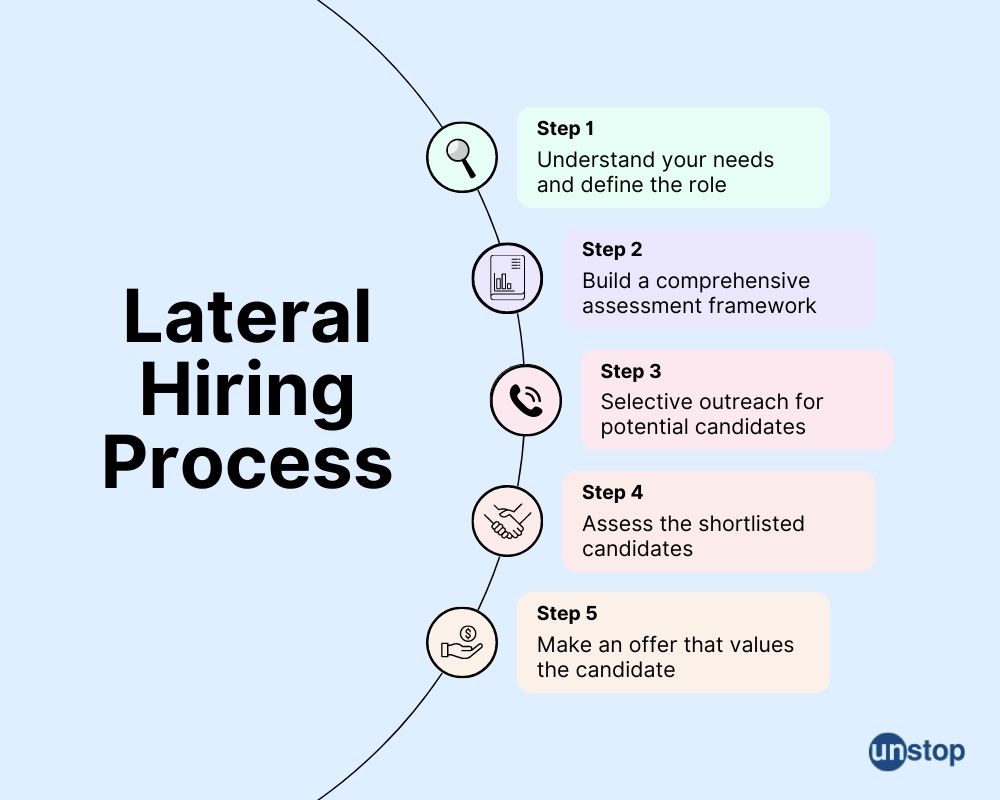In today's fast-paced and competitive job market, organizations are constantly seeking innovative strategies to attract and retain top talent. One such strategy that has gained significant traction is lateral recruiting. This approach, often overlooked in favor of traditional hiring practices, can be a game-changer for businesses aiming to inject fresh perspectives and specialized skills into their workforce. But what exactly is lateral recruiting, and how can it benefit your organization? Let's delve into this concept to understand its importance and potential impact on your business.
Understanding Lateral Recruiting
Lateral recruiting, also known as lateral hiring or lateral movement, involves hiring employees from the same level or position in another organization, rather than promoting from within or hiring at entry-level. Essentially, it focuses on bringing in talent that already possesses the necessary experience and expertise, allowing them to transition seamlessly into similar roles within a new company.
Unlike traditional recruiting, where the emphasis is often on filling entry-level positions or promoting existing employees, lateral recruiting targets mid-to-senior level professionals. These individuals have a proven track record, industry knowledge, and the ability to hit the ground running, making them valuable assets to any organization.
Why Organizations Turn to Lateral Recruiting
Organizations may choose lateral recruiting for various reasons, ranging from filling critical skill gaps to fostering innovation. Here are some of the key motivations behind this strategic hiring approach:
1. Filling Skill Gaps
In many industries, certain roles require highly specialized skills that are not easily developed internally or found in the entry-level talent pool. Lateral recruiting allows organizations to quickly fill these gaps by bringing in professionals who already have the required expertise. This is particularly beneficial in fields like technology, healthcare, and finance, where specific technical knowledge or certifications are essential.
2. Accelerating Growth
Lateral hires can significantly accelerate an organization's growth. Since these professionals are already experienced in their field, they require less time to acclimate and start contributing effectively. This can be crucial in fast-growing companies or industries where speed to market is a competitive advantage.
3. Enhancing Organizational Diversity
Lateral recruiting can also be a powerful tool for enhancing diversity within an organization. By bringing in talent from different companies, industries, or even geographical locations, businesses can introduce new perspectives and ideas. This diversity of thought can lead to more innovative solutions and a more inclusive workplace culture.
4. Reducing Training Costs
Training new employees can be time-consuming and costly, especially when they are hired at an entry level. Lateral recruits, however, often come with the necessary experience and skills, reducing the need for extensive training programs. This not only saves time and money but also allows the organization to allocate resources more efficiently.
The Process of Lateral Recruiting
Lateral recruiting is not just about filling positions; it requires a strategic approach to identify, attract, and retain the right talent. Here’s how organizations typically go about it:
1. Identifying Talent Needs
The first step in lateral recruiting is to identify specific talent needs within the organization. This involves assessing current skill gaps, future growth plans, and the overall business strategy. Understanding these needs helps in targeting the right candidates who can add immediate value.
2. Targeting the Right Candidates
Once the needs are identified, the next step is to target candidates who possess the required skills and experience. This can be done through various channels, such as professional networks, industry conferences, or specialized recruitment firms. It’s important to focus on candidates who not only have the right qualifications but also align with the company’s culture and values.
3. Offering Competitive Compensation
Attracting top lateral talent often requires offering competitive compensation packages. Since these professionals are likely already established in their careers, they may not be easily swayed by standard offers. Organizations may need to provide incentives such as signing bonuses, stock options, or flexible work arrangements to make the opportunity more appealing.
4. Onboarding and Integration
Successful lateral recruiting doesn’t end with hiring; the onboarding process is equally crucial. New hires should be integrated into the team in a way that leverages their existing skills while also helping them adapt to the company’s culture. Providing mentorship, clear expectations, and opportunities for professional growth can ensure a smooth transition and long-term success.

Source: unstop.com
Benefits of Lateral Recruiting
Lateral recruiting offers numerous benefits that can give organizations a competitive edge in the market. Below are some of the most significant advantages:
1. Immediate Impact on Performance
One of the most compelling reasons to engage in lateral recruiting is the immediate impact it can have on organizational performance. Unlike entry-level hires, who may require months of training and acclimation, lateral hires can start contributing from day one. This immediate infusion of talent can be critical in achieving short-term business objectives.
2. Increased Innovation and Creativity
Bringing in professionals from outside the organization introduces new ideas, perspectives, and approaches to problem-solving. This diversity of thought can lead to increased innovation, helping the organization to stay ahead of competitors and adapt to changing market conditions.
3. Strengthened Competitive Position
In many industries, having the right talent is a key differentiator. By recruiting experienced professionals from competitors or related fields, organizations can gain a competitive advantage. These hires bring not only their skills but also insights into industry trends, customer preferences, and competitor strategies.
4. Enhanced Organizational Agility
Lateral hires can also enhance an organization’s agility. Their experience and expertise enable them to quickly adapt to changes in the market or industry. This flexibility is particularly valuable in dynamic environments where the ability to pivot quickly can make the difference between success and failure.
5. Reduced Risk of Attrition
Lateral recruits are often more stable in their career trajectories compared to entry-level employees. They are typically looking for opportunities where they can make a meaningful impact and grow within the organization. As a result, they may be less likely to leave for other opportunities, reducing turnover and the associated costs.
Challenges and Considerations in Lateral Recruiting
While lateral recruiting offers many benefits, it is not without its challenges. Organizations must carefully consider the following aspects to ensure a successful lateral hiring strategy:
1. Cultural Fit
One of the biggest risks in lateral recruiting is the potential for cultural misalignment. Even if a candidate has the right skills and experience, they may struggle to integrate into the company’s culture. To mitigate this risk, organizations should prioritize cultural fit during the recruitment process and provide support during the onboarding phase.
2. Compensation Disparities
Lateral hires often command higher salaries than their internally promoted counterparts. This can lead to compensation disparities within the organization, potentially causing dissatisfaction among existing employees. To address this, companies should establish clear compensation guidelines and ensure transparency in how salaries are determined.
3. Resistance to Change
Introducing new talent at senior levels can sometimes lead to resistance from existing employees, especially if they feel overlooked for promotions. It’s important to communicate the rationale behind lateral hires and emphasize the benefits they bring to the team. Providing opportunities for existing employees to develop their skills and advance their careers can also help alleviate concerns.
4. Integration Challenges
Lateral recruits may face challenges in integrating into their new roles, especially if they come from different industries or organizational cultures. Companies should invest in comprehensive onboarding programs that include mentorship, training, and regular check-ins to ensure a smooth transition.
In Summary Leveraging Lateral Recruiting for Organizational Success
Lateral recruiting is a powerful strategy that can bring significant benefits to organizations, from filling critical skill gaps to driving innovation and enhancing competitive advantage. By carefully identifying talent needs, targeting the right candidates, and providing a supportive onboarding experience, companies can maximize the value of lateral hires.
However, it’s important to approach lateral recruiting with a clear understanding of the potential challenges and a strategy to address them. When done correctly, lateral recruiting can be a key driver of organizational growth and success, helping businesses to thrive in an increasingly competitive and dynamic market.
Incorporating lateral recruiting into your overall talent strategy can ensure that your organization not only attracts the best talent but also positions itself for long-term success. As the business landscape continues to evolve, those who effectively leverage lateral recruiting will be better equipped to navigate the challenges and seize the opportunities that lie ahead.




























